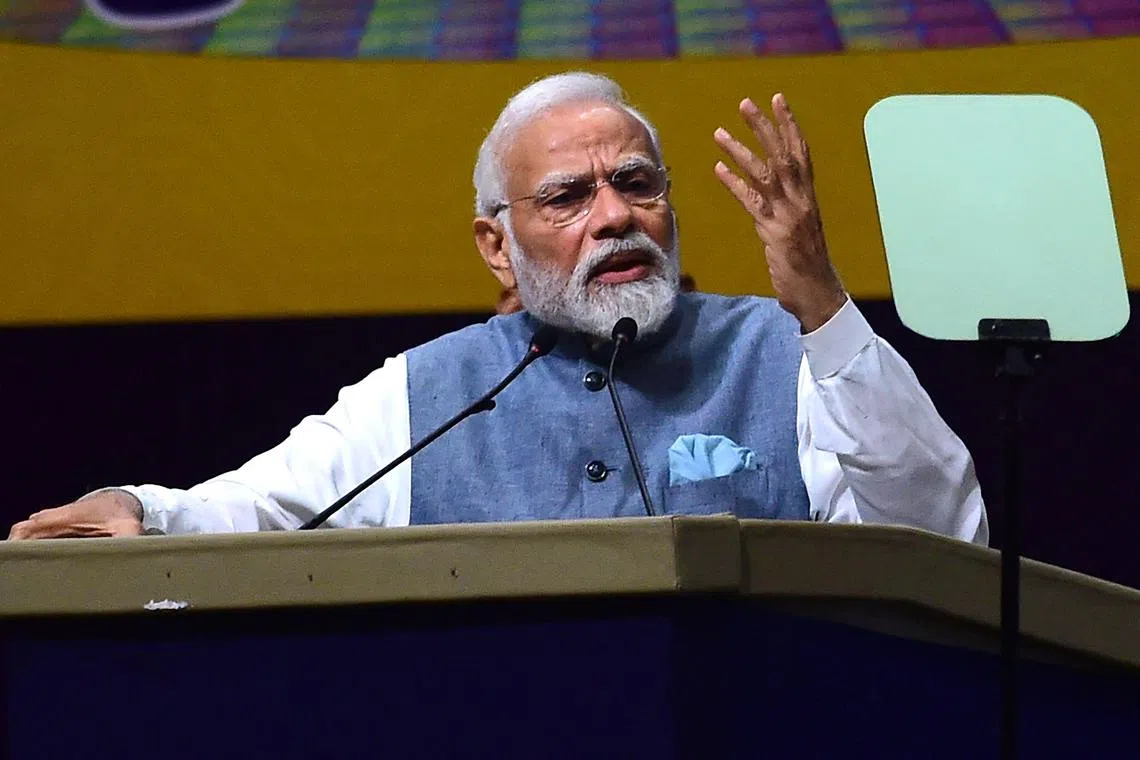Religious violence in India threatens to tar Modi’s image before G-20
Sign up now: Get ST's newsletters delivered to your inbox

Indian Prime Minister Narendra Modi has remained silent on the latest clashes near New Delhi.
PHOTO: AFP
Follow topic:
NEW DELHI – As Prime Minister Narendra Modi prepares to welcome the Group of 20 (G-20) leaders in September, some of the worst religious violence in years threatens to taint his efforts to showcase India as a strategic counterweight and investment alternative to China.
Clashes between Hindus and Muslims this week
Mr Modi has remained silent on the latest clashes near the capital, which come on the heels of worsening conditions in the north-eastern state of Manipur some 2,500km away. A video that emerged from there in July of two women being paraded naked and allegedly raped
The incidents add pressure on Mr Biden and other democratic leaders to speak out about human rights concerns in the world’s most-populous nation, which the US in particular has sought to avoid while courting India to distance itself from Russia and counter China’s growing assertiveness. In June, Secretary of State Antony Blinken said the US-India partnership “is closer, it’s broader, it is more dynamic than it has ever been”.
The religious and ethnic clashes have “the potential to adversely impact the image of India as a desirable and safe investment and manufacturing option”, said Mr C. Uday Bhaskar, director of the Society for Policy Studies in New Delhi.
More so “in relation to the ‘de-risking and minimise China policy’ being pursued by the US and its allies”, he added.
The stakes are high for Mr Modi, who faces an election in 2024 in which he is expected to extend his 10 years in power. While many voters credit Mr Modi as a strong leader who has accelerated India’s development and boosted its clout on the world stage, critics say his Hindu-dominant Bharatiya Janata Party has made the country less tolerant of minorities – a trend exemplified by the recent violence.
Since rising to power in 2014, Mr Modi has come under fire by opposition groups for pushing a pro-Hindu agenda
Still, Mr Modi remains popular, with an approval rating consistently above 60 per cent. He is expected to easily win a no-confidence vote filed by the opposition over the violence in Manipur that is scheduled for next week.
Around New Delhi, posters depicting Mr Modi and the G-20 logo adorn the streets.
Global industry leaders are also expected to attend a sideline meeting as India looks to attract companies seeking to shift some manufacturing away from China.
On Wednesday, representatives for G-20 nations attended a special briefing by India’s Ministry of External Affairs, even as security forces continued to patrol Gurugram, a city just outside New Delhi where global firms such as Microsoft and Alphabet’s Google have offices.
Tensions have simmered in Gurugram and nearby towns in the state of Haryana after Hindus and Muslims clashed during a religious procession by Hindu groups on Monday.

A protest over sexual violence against women and for peace in the ongoing ethnic violence in India’s north-eastern state of Manipur, in Amritsar, on July 24.
PHOTO: AFP
Videos surfacing on social media and television news channels showed mobs throwing stones, vandalising shops and setting cars on fire. The violence is the worst in India’s capital region since 2020, when 52 people, mostly Muslims, were killed in communal clashes.
Congress leader Priyanka Gandhi Vadra has called for unity, saying the politics of “divide and rule” were the biggest hindrance to fixing the more pressing issues of employment and development.
India is grappling with similar, identity-driven conflicts in Manipur between minority tribal groups and majority Meitei Hindus over affirmative action policies.
The video of the two naked women pushed Mr Modi to make his first public comments on sexual assaults in Manipur, which borders Myanmar in north-eastern India. A mass burial of more than 30 people killed in skirmishes was postponed on Thursday because of concerns about more violence, according to Mr Golan Suanzamung Naulak of the Zomi Council Steering Committee in Manipur.
Fallout from the video also resulted in the no-confidence motion against Mr Modi.
Though the ruling party has enough seats in Parliament to protect the Prime Minister, the violence is “definitely going to cast a shadow on the G-20 summit”, said Mr Sushant Singh, a senior fellow at the Centre for Policy Research, a New Delhi-based think-tank.
The situation “does not reflect well on Modi’s leadership and political abilities to deal with India’s numerous diversities”, he said. BLOOMBERG

